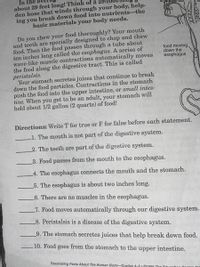
Human Anatomy & Physiology (11th Edition)
11th Edition
ISBN: 9780134580999
Author: Elaine N. Marieb, Katja N. Hoehn
Publisher: PEARSON
expand_more
expand_more
format_list_bulleted
Question

Transcribed Image Text:In the
about 29 feet long! Think of a 29-
den hose that winds through your body, help-
ing you break down food into nutrients-the
basic materials your body needs.
Do you chew your food thoroughly? Your mouth
and teeth are specially designed to chop and chew
food. Then the food passes through a tube about
ten inches long called the esophagus. A series of
wave-like muscle contractions automatically moves
the food along the digestive tract. This is called
peristalsis.
Your stomach secretes juices that continue to break
down the food particles. Contractions in the stomach
push the food into the upper intestine, or small intes-
tine. When you get to be an adult, your stomach will
hold about 1/2 gallon (2 quarts) of food!
food moving.
down the
esophagus
Directions: Write T for true or F for false before each statement.
1. The mouth is not part of the digestive system.
_2. The teeth are part of the digestive system.
3. Food passes from the mouth to the esophagus.
4. The esophagus connects the mouth and the stomach.
5. The esophagus is about two inches long.
6. There are no muscles in the esophagus.
7. Food moves automatically through our digestive system.
8. Peristalsis is a disease of the digestive system.
9. The stomach secretes juices that help break down food.
10. Food goes from the stomach to the upper intestine.
Fascinating Facts About The Human Body-Grades 4-fi: 01995 Thn
ODDOC
Expert Solution
This question has been solved!
Explore an expertly crafted, step-by-step solution for a thorough understanding of key concepts.
This is a popular solution
Trending nowThis is a popular solution!
Step by stepSolved in 2 steps with 1 images

Knowledge Booster
Learn more about
Need a deep-dive on the concept behind this application? Look no further. Learn more about this topic, biology and related others by exploring similar questions and additional content below.Similar questions
- Topic: Pig Dissectionarrow_forwardStation 6: large intestines Observe the available medical images and/or specimens. a. What do you notice about the available specimen(s) and/or medical images? b. What specific parts of these organs or structures can you point out?arrow_forwardCan you answer the highlighted questions (4-6) for the digestive system? The first three questions already been answered.Selected System: Digestive system.How to support the claim that the body is a system of interacting subsystems composed of groups of cells. (In Digestive system) The following to be answered in supporting the claim for Digestive system: Body system function (What are the main functions of the body system?) Organization of the system (What cells, tissues, and organs are part of the system?) Function of smaller parts within the system (how do the functions of cells, tissues, and organs contribute to the overall function of the body system) Body system interactions (How does your system work with other systems) Impact of disease, disorder, infection, or injury on the body system (how does a particular disease, disorder, infection or injury affect this system) Impact of body system failure on the body (If your body system is damaged or fails, how are other body…arrow_forward
- The child in Slide B presents for a new patient assessment. She is 6 years old. You evaluate her dentition and note permanent teeth have erupted in the mandibular arch. You know this because: A - Primary teeth are lighter in color B-Permanent mandibular incisors begin to erupt at 6-7 years of age C-Permanent mandibular incisors usually have mamelons D- A,B E- A,B and Carrow_forwardDiscuss whether the esophagus in Barret's esophagus is able to perform its normal functionarrow_forward
arrow_back_ios
arrow_forward_ios
Recommended textbooks for you
 Human Anatomy & Physiology (11th Edition)BiologyISBN:9780134580999Author:Elaine N. Marieb, Katja N. HoehnPublisher:PEARSON
Human Anatomy & Physiology (11th Edition)BiologyISBN:9780134580999Author:Elaine N. Marieb, Katja N. HoehnPublisher:PEARSON Biology 2eBiologyISBN:9781947172517Author:Matthew Douglas, Jung Choi, Mary Ann ClarkPublisher:OpenStax
Biology 2eBiologyISBN:9781947172517Author:Matthew Douglas, Jung Choi, Mary Ann ClarkPublisher:OpenStax Anatomy & PhysiologyBiologyISBN:9781259398629Author:McKinley, Michael P., O'loughlin, Valerie Dean, Bidle, Theresa StouterPublisher:Mcgraw Hill Education,
Anatomy & PhysiologyBiologyISBN:9781259398629Author:McKinley, Michael P., O'loughlin, Valerie Dean, Bidle, Theresa StouterPublisher:Mcgraw Hill Education, Molecular Biology of the Cell (Sixth Edition)BiologyISBN:9780815344322Author:Bruce Alberts, Alexander D. Johnson, Julian Lewis, David Morgan, Martin Raff, Keith Roberts, Peter WalterPublisher:W. W. Norton & Company
Molecular Biology of the Cell (Sixth Edition)BiologyISBN:9780815344322Author:Bruce Alberts, Alexander D. Johnson, Julian Lewis, David Morgan, Martin Raff, Keith Roberts, Peter WalterPublisher:W. W. Norton & Company Laboratory Manual For Human Anatomy & PhysiologyBiologyISBN:9781260159363Author:Martin, Terry R., Prentice-craver, CynthiaPublisher:McGraw-Hill Publishing Co.
Laboratory Manual For Human Anatomy & PhysiologyBiologyISBN:9781260159363Author:Martin, Terry R., Prentice-craver, CynthiaPublisher:McGraw-Hill Publishing Co. Inquiry Into Life (16th Edition)BiologyISBN:9781260231700Author:Sylvia S. Mader, Michael WindelspechtPublisher:McGraw Hill Education
Inquiry Into Life (16th Edition)BiologyISBN:9781260231700Author:Sylvia S. Mader, Michael WindelspechtPublisher:McGraw Hill Education

Human Anatomy & Physiology (11th Edition)
Biology
ISBN:9780134580999
Author:Elaine N. Marieb, Katja N. Hoehn
Publisher:PEARSON

Biology 2e
Biology
ISBN:9781947172517
Author:Matthew Douglas, Jung Choi, Mary Ann Clark
Publisher:OpenStax

Anatomy & Physiology
Biology
ISBN:9781259398629
Author:McKinley, Michael P., O'loughlin, Valerie Dean, Bidle, Theresa Stouter
Publisher:Mcgraw Hill Education,

Molecular Biology of the Cell (Sixth Edition)
Biology
ISBN:9780815344322
Author:Bruce Alberts, Alexander D. Johnson, Julian Lewis, David Morgan, Martin Raff, Keith Roberts, Peter Walter
Publisher:W. W. Norton & Company

Laboratory Manual For Human Anatomy & Physiology
Biology
ISBN:9781260159363
Author:Martin, Terry R., Prentice-craver, Cynthia
Publisher:McGraw-Hill Publishing Co.

Inquiry Into Life (16th Edition)
Biology
ISBN:9781260231700
Author:Sylvia S. Mader, Michael Windelspecht
Publisher:McGraw Hill Education